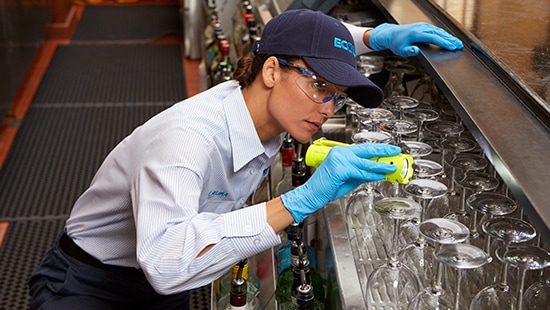Pest Control Services Near Me Chicago: Effective Solutions for All Pests
Wiki Article
A Comprehensive Overview to the Different Kinds Of Bug Control Methods
With the myriad of insect control techniques offered, it can be frustrating to locate the most effective service for a particular insect trouble. In this detailed overview, we will certainly check out these various types of insect control techniques, using insights right into their applications and benefits. By the end, you will certainly have a more clear understanding of which approach may be the best fit for your pest control needs.Chemical Parasite Control Approaches

One common type of chemical pest control is insecticides. Insecticides target particular insects, such as insects, termites, or ants, and can be made use of both inside and outdoors.
Another kind of chemical bug control is rodenticides. These are chemical materials created to regulate populations of rats, such as rats and computer mice.
Herbicide, likewise known as herbicides, are an additional sort of chemical parasite control method. Herbicides are developed to selectively eliminate undesirable plants, referred to as weeds, without triggering injury to preferable plants. They are commonly made use of in agriculture, landscaping, and gardening to regulate the growth of unwanted vegetation.
While chemical insect control methods can be highly effective in eliminating parasites, it is very important to use them sensibly and follow safety standards. Overuse or abuse of chemical pesticides can have negative effect on human wellness and the environment. It is essential to use these techniques sensibly and think about different parasite control techniques whenever possible.
Organic Insect Control Techniques
Biological bug control techniques entail making use of living microorganisms or natural materials to take care of and regulate pest populaces. Unlike chemical methods, which often depend on synthetic chemicals, biological control approaches make use of the all-natural opponents of insects to regulate their populations. This strategy is considered more eco-friendly and sustainable, as it reduces the use of harmful chemicals and lessens the risk of pesticide resistance.One extensively utilized organic insect control method is the intro of natural predators or bloodsuckers. As an example, ladybugs are presented to control aphids, while particular wasp varieties are released to target caterpillars. These killers and bloodsuckers feed on pests, minimizing their numbers and protecting against infestations.
Another organic control method is using microorganisms. Particular microorganisms, infections, and fungis can be utilized to infect and eliminate certain insects. As an example, the germs Bacillus thuringiensis is commonly used to manage caterpillars, as it creates toxins that are dangerous to these parasites.
Organic control methods can also involve using scents or all-natural substances that disrupt the breeding patterns of parasites. By hindering their reproduction, these techniques help to decrease pest populations gradually.
While biological insect control techniques are usually efficient, they may need longer durations to attain preferred results compared to chemical approaches. Additionally, careful consideration should be given to the option and release of all-natural adversaries to avoid unexpected harm to helpful organisms or ecosystems.
Physical Pest Control Techniques
To properly take care of and manage pest populations, alternate parasite control methods referred to as physical pest control approaches are used. These approaches entail making use of physical obstacles, catches, or tools to prevent parasites from accessing or harming home. One typical physical insect control approach is the use of displays or webs to maintain pests out of buildings or yards. These displays are normally constructed from fine mesh material that enables air flow while protecting against parasites from going into. One more physical pest control method is the installation of fencings or walls to maintain bigger parasites, such as deer or rabbits, out of yards or farming fields. These obstacles literally obstruct the parasites' accessibility to the location, minimizing the capacity for damages. In addition, catches and gadgets can be used to record or repel bugs. As an example, sticky catches can be put in areas where bugs are an issue, and the bugs come to be stuck to the sticky surface area. Ultrasonic tools can likewise be used to give off high-frequency sounds that are unpleasant to insects, creating them to leave the location. Physical bug control techniques are an eco friendly choice to chemical pesticides, as they do not count on the usage of unsafe chemicals.All-natural Pest Control Techniques
All-natural insect control methods provide look at here a lasting and environmentally friendly approach to handling and eliminating insects. One of the most common natural insect control methods is organic control. By adopting these all-natural parasite control approaches, individuals and communities can efficiently handle insects while lessening the unfavorable impacts on the setting and human wellness.Integrated Pest Management (IPM)
Integrated Insect Monitoring (IPM) is a detailed and systematic technique to pest control that combines various techniques and techniques to efficiently handle parasites while minimizing the usage of chemical pesticides. IPM aims to keep insect populations below the financial injury degree by using a combination of social, biological, and chemical control methods.
Cultural control approaches entail modifying the environment to make it less beneficial for insects. This can include methods such as plant rotation, appropriate sanitation, and the use of resistant plant selections. By creating negative click here now problems for bugs, cultural control techniques can significantly decrease insect populations.

Chemical control methods are utilized as a last hotel in IPM. They involve the targeted and sensible use chemicals to manage bug populaces. Unlike conventional bug control approaches, IPM intends to minimize making use of chemical pesticides by employing alternate approaches.
Integrated Insect Management (IPM) is a positive strategy that focuses on long-term bug monitoring rather than depending only on responsive measures. By combining several control techniques, IPM gives a more lasting and eco-friendly technique to pest control.
Verdict
It talked about chemical, biological, physical, and all-natural parasite control techniques, as well as the integrated parasite monitoring strategy. By recognizing these pest control training different methods, people can make informed choices on which bug control method is most ideal for their specific needs and preferences.Report this wiki page